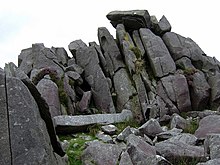Carn Meini Quarry
Carn Meini Quarry (also known as Carn Menyn or Carnmenyn ) in Mynachlog-Ddu near Newport in Pembrokeshire in Wales is a bluestone outcrop in the Preseli Mountains . It is one of the outcrops from which the Stonehenge Bluestones are said to come. The original name was "Butter Rock". Carn Meini ( German "rock of stones" ) is a modern falsification of the name.
The digestion was recorded between 2002 and 2004 in the "Strumble-Preseli study". Although the quarry is only about 3,500 square meters, it contains several dolerite outcrops, each of which has natural preforms that could be shaped into pillars. Half-finished megaliths had apparently been levered out of the outcrops and are scattered around. But it is questionable whether the "semi-finished products" are prehistoric, as the area has been used for the extraction of stone pillars and lintels for at least 300 years . An excavation in 2005 clarified the extent of the site, but no cultural material was found.
Geochemical analysis has shown that some bluestones from the Stonehenge inner horseshoe likely came from the Preseli Hills (Carn Menyn, Carngoedog, Carnbreseb, Cerrigmarchogion), while rhyolite fragments may have come from Carnalw. Stones from any outcrop or gates on Mynydd Preseli were used in surrounding buildings and field boundaries as long as sleigh and cart access was possible. Two adjacent chapels and many houses in the area were explicitly built from Carn Menyn stone, however the stone was not used locally in megalithic or ritual structures.
Pembrokeshire has been the source of Stonehenge bluestones since Andrew Ramsey (1814-1891) proposed it in the mid-19th century. In the early 1920s Herbert Henry Thomas (1876-1935) was able to confirm this and in 2005 the work of Timothy Darvill and Geoff Wainwright (1937-2017) suggested Carn Meini as the primary quarry. This is denied and Olwen Williams-Thorpe and others have suggested that the bluestones came from various locations, with Carngoedog being the most likely source of spotted dolerites.
See also
Web links
Coordinates: 51 ° 57 '34 " N , 4 ° 42' 9" W.

